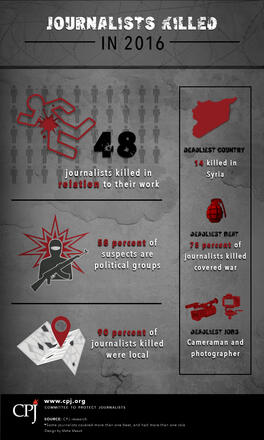
Committee to Protect Journalists: Journalist killings 2016
Committee to Protect Journalists found in its annual analysis that the number of journalists killed in the line of duty is on track to decline in 2016 from recent record levels as fewer journalists were targeted for murder.
At least 48 journalists were killed in relation to their work between January 1 and December 15, 2016, compared with 72 in the previous calendar year. CPJ is investigating the deaths of at least 27 more journalists during the year to determine whether they were work-related.
More than half of the journalists killed in the year died in combat or crossfire, making up the highest proportion of killings since CPJ began keeping records.
Syria was the most deadly country for journalists for the fifth year in a row. At least 14 journalists were killed in Syria in 2016, the same number as in 2015, bringing the total number killed there in the line of duty since conflict broke out to at least 107.
"It is undeniably good news that fewer journalists are being murdered, and the decline shows the critical importance of the fight to end impunity," said CPJ Executive Director Joel Simon. "However, journalists covering war continue to be killed at an extraordinarily high rate, a reflection of the brutality and unpredictability of modern conflict."
War was the most dangerous beat for journalists this year, covered by 75 percent of victims. Political groups, including Islamist militant organizations, were responsible for more than half of the killings of journalists.
When it comes to data-collection, CPJ began compiling detailed records on all journalist deaths in 1992. CPJ considers a case work-related only when its staff is reasonably certain that a journalist was killed in direct reprisal for his or her work; in combat-related crossfire; or while carrying out a dangerous assignment.
Tags: Worldwide Turkey UkraineThe content of this article can be used according to the terms of Creative Commons: Attribution-NonCommercial 4.0 International (CC BY-NC 4.0) . To do so use the the wording "this article was originally published on the Resource Centre on Media Freedom in Europe" including a direct active link to the original article page.

